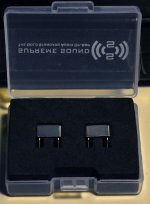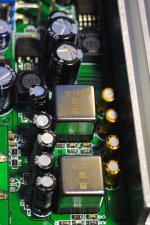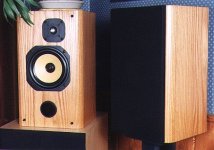Burson audio sent me a pair of these opamps to try out. Here are my listening impressions. First, gear used. I used the opamps in an Aiyima A04, a fairly popular small Class D amp. My speakers are Focal 133's, custom Zalytrons from the 90's with Focal drivers; 7” double voice coil kevlar woofers and 1” titanium tweeters in a vented 15 litre box. I've used them for over 20 years as critical reference for test mixes. Mistakes are obvious, but when everything's right they are a dream. My source is a PC playing digital mp3's at 320 kbps 48 kHz. I had previously replaced the stock opamps in the aiyima with OPA1656's.
The Burson opamps come in a tidy package, snugged into a thick slab of rubber which fits in a small custom plastic hinged box. They are encased in metal and were extremely easy to slip into the amp's sockets. Once the top was off, 30 seconds for the entire operation. As soon as I put on the first track I was gobsmacked by highs. Really bright and nowhere near the bottom I was used to. But incredible soundstage. So I let them run for a week before listening critically. After 60 or so hours they had smoothed out nicely. All the bass was back. But they still had somewhat edgy highs. I listen to mostly jazz, which can run the gamut. But acoustic stuff is my favorite. What knocked me out was the great ambience. Reflections in the room were clearly more obvious. After a couple of weeks listening to the broken in chips the overall sound still strikes me as too bright for my ears. The OPA1656's just sound wonderful and non fatiguing. The Burson chips seem to have more pizazz but I get a sensation of earache almost right away. I've always been sensitive to midrange and that may be part of it. Guitars usually seem over mixed to me. If you're into electronic music they may be just the ticket.
The Burson opamps come in a tidy package, snugged into a thick slab of rubber which fits in a small custom plastic hinged box. They are encased in metal and were extremely easy to slip into the amp's sockets. Once the top was off, 30 seconds for the entire operation. As soon as I put on the first track I was gobsmacked by highs. Really bright and nowhere near the bottom I was used to. But incredible soundstage. So I let them run for a week before listening critically. After 60 or so hours they had smoothed out nicely. All the bass was back. But they still had somewhat edgy highs. I listen to mostly jazz, which can run the gamut. But acoustic stuff is my favorite. What knocked me out was the great ambience. Reflections in the room were clearly more obvious. After a couple of weeks listening to the broken in chips the overall sound still strikes me as too bright for my ears. The OPA1656's just sound wonderful and non fatiguing. The Burson chips seem to have more pizazz but I get a sensation of earache almost right away. I've always been sensitive to midrange and that may be part of it. Guitars usually seem over mixed to me. If you're into electronic music they may be just the ticket.
Attachments
How do you imagine an opamp of any sort can lack bass and slowly recover it? It can only sense the instantaneous error voltage at the input, it has no way to know what part of that is low frequency components and what part is high frequency!!!
Frequency response of an opamp circuit is set by the feedback network, not the opamp.
Perhaps if you'd measured the frequency reponse you'd have found it was stable over time and you imagined the change?
Frequency response of an opamp circuit is set by the feedback network, not the opamp.
Perhaps if you'd measured the frequency reponse you'd have found it was stable over time and you imagined the change?
How do you imagine an opamp of any sort can lack bass and slowly recover it? It can only sense the instantaneous error voltage at the input, it has no way to know what part of that is low frequency components and what part is high frequency!!!
Frequency response of an opamp circuit is set by the feedback network, not the opamp.
Perhaps if you'd measured the frequency reponse you'd have found it was stable over time and you imagined the change?
100%
BTW it could be that the response was changing over time, and that indicates a serious problem with the circuit.
Another issue to be aware of is the Burson opamps have _extremely_ high bias currents, according to the datasheets available, and will no be suitable for many circuits.
Another issue to be aware of is the Burson opamps have _extremely_ high bias currents, according to the datasheets available, and will no be suitable for many circuits.
Electronic components over time go to normal operating modes, "warm up". So everything is correct about the change in the sound of the new operational amplifiers.
Thanks for the information!
Thanks for the information!
OpAmp Burson was originally designed to emulate distortion that is pleasing to the ear.
Try the LME49860 in DIP, I really liked it.
Try the LME49860 in DIP, I really liked it.
Hello.My Aiyima A04 works with Muses 8920. I really like the sound - melodic, dense, gentle.
Where did you buy 8920, if possible, photo.
Hello!Hello.
Where did you buy 8920, if possible, photo.
8920 removed from the Chinese dac Weiliang dc200. I like this Dac, it costs $450, but I can't vouch for the originality of Muses 🙂
Thanks Artgu!Hello!
8920 removed from the Chinese dac Weiliang dc200. I like this Dac, it costs $450, but I can't vouch for the originality of Muses 🙂
View attachment 1020420
Today I will pick up the chips at the post office, probably also from China. Our company sells.
Hey @bonjonno (or anyone else on this older thread), I had a question about use of the Burson Op-Amps with either the Aiyima A04 or A07. I guess Burson is on the march again to get more user reviews, so they just sent me some V5i and V6 Vivid amps, plus the long extension legs so I can use the V6 Vivids with the amps (cap spacing too tight to fit the Vivids into either amp). My question is, were these amps plug and play, did they require any modifications or set up any bad oscillations? I want to try them out but also protect my amps. I fitted the V5i ones into the A04 last night but have not fired it up as yet. Thanks for any advice/previous experience!
Opamps are not in general plug and play. Some need more decoupling, some have high bias currents (I think the V5 ad V6 differ in this respect, but they share a pitifully tiny datasheet so who knows?), some will tolerate +/18V and others don't.
Have been using LM4562 op-amps without problems, those replaced the 5532's that came with the amps. I reached out to Aiyima directly, but they have not directly tested any Bursons.
Still hoping to hear from anyone who has used them in Aiyima amps and whether there were any noticeable problems. I have a test group of components I use for this sort of thing (cheap KLH mini speakers, cd/dvd deck) but I'd still rather not blow the amps if I can avoid it.
Still hoping to hear from anyone who has used them in Aiyima amps and whether there were any noticeable problems. I have a test group of components I use for this sort of thing (cheap KLH mini speakers, cd/dvd deck) but I'd still rather not blow the amps if I can avoid it.
Actually, the Burson V5i datasheet looks pretty detailed to me...definitely some different parameters there than an LM4562?
Input bias - 10 nA (4562), 3 uA (V5i)
Offset voltage - 0.1 mV (4562), 3 mV (V5i)
Voltage range - +/- 2.5v - 17v (4562), +/- 5v - 16v/32v (V5i)
Slew rate - +/- 20 uS (4562), max 50 uS (V5i)
Bursons tested with a 15v supply voltage.
Input bias - 10 nA (4562), 3 uA (V5i)
Offset voltage - 0.1 mV (4562), 3 mV (V5i)
Voltage range - +/- 2.5v - 17v (4562), +/- 5v - 16v/32v (V5i)
Slew rate - +/- 20 uS (4562), max 50 uS (V5i)
Bursons tested with a 15v supply voltage.
I used the Vivids with my A07, there's no issue, or one that I noticed anyway. I've reverted back to the stock op-amps for now.Have been using LM4562 op-amps without problems, those replaced the 5532's that came with the amps. I reached out to Aiyima directly, but they have not directly tested any Bursons.
Still hoping to hear from anyone who has used them in Aiyima amps and whether there were any noticeable problems. I have a test group of components I use for this sort of thing (cheap KLH mini speakers, cd/dvd deck) but I'd still rather not blow the amps if I can avoid it.
Well, decided to take the risk...the V5i op-amps seem to work OK in my Aiyima A04 amp, plan to listen over the weekend and compare to the LM4562 chips and the other V6 Vivid amps with the long extension leads and top off the case. On first listen, the sound did not seem overly bright, which is what a lot of others have mentioned.
- Home
- Amplifiers
- Class D
- Burson Audio Opamps V5i in Aiyima A04


